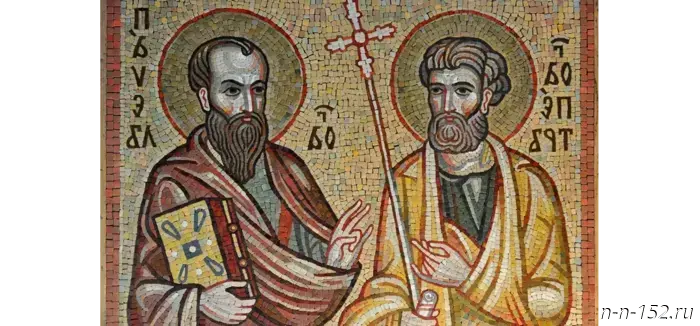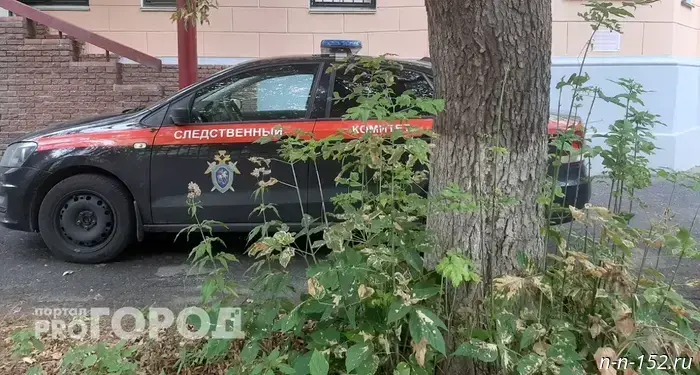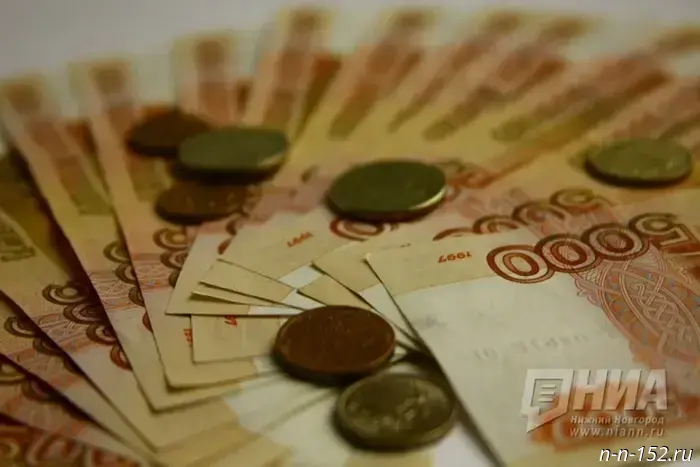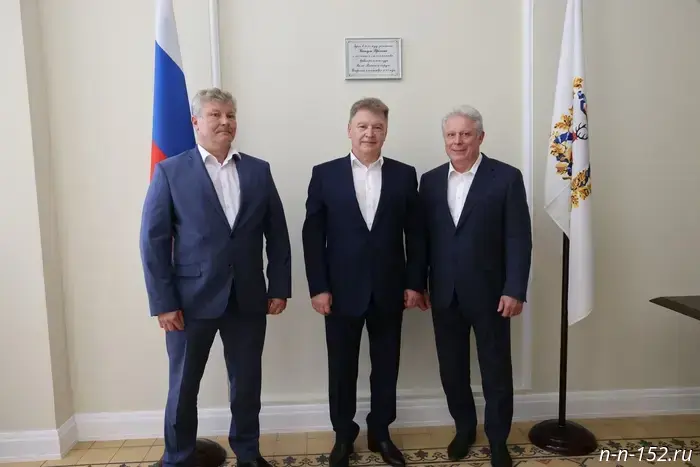
July 12th — The feast day of the Holy Prime Apostles Peter and Paul
Tatiana Garina's Text
July 12 — Day of Remembrance for the Holy Apostles Peter and Paul, the foremost apostles. The holiday was established on this day in connection with the transfer of the relics of the Holy Apostles to Rome in 258 AD from their original burial sites in catacombs. Later, they were returned: the relics of Apostle Peter were moved to the Vatican, and those of Apostle Paul to the Via Ostiensis. In the 4th century, the Holy and Equal-to-the-Apostles Emperor Constantine the Great revived the celebration, as he considered himself a successor of the apostles and built churches in their honor in Rome and Constantinople. However, over time, even this event was forgotten, and the day came to be understood within the Christian tradition as a day of the common martyrdom of Saints Peter and Paul. As Blessed Augustine said, "although they suffered on different days, in spirit and in the closeness of their suffering they are one."
The apostles Peter and Paul are called the foremost because they hold the leading role in the spread of Christianity. Peter (Simon), from a family of fishermen, was one of Jesus Christ’s favorite disciples. The Savior specifically assigned him the role of founder of the Church: "And I tell you that you are Peter, and on this rock I will build my church, and the gates of Hades will not overcome it" (Matthew 16:18).
Apostle Paul (Saul) was born into a wealthy Jewish family in the city of Tarsus in Asia Minor. For a long time, he was a persecutor of Christians himself. After a miraculous conversion, his subsequent activity involved missionary work throughout the Roman Empire, preaching Christianity to the Gentiles.
Saint Apostle Peter arrived in Rome in the 60s AD. Here, he converted many to Christ. In Rome, he wrote the Second Epistle to the Christians, who had turned from Jews and Gentiles and were in exile in Asia Minor. The Lord foretold his imminent departure from this life: “I must soon leave this body, as the Lord Jesus Christ has revealed to me. I will do my best to remind you of these things even after I am gone” (2 Peter 1:14-15). During Nero's persecution, Saint Apostle Peter was captured and imprisoned in the Mamertine Prison. From there, he was taken to the Vatican Hill, located on the right bank of the Tiber River, where Nero's circus was situated. Here, the saint heroically accepted martyrdom. Like his Teacher, Peter was crucified, but out of humility, he asked to be crucified upside down. He was buried on the Vatican Hill. When excavations were conducted in 1941 in the basement of St. Peter's Cathedral, a slab with a brief and very expressive inscription in Greek was found at this very site: "Peter is here."
The time of Saint Apostle Paul’s arrival in Rome is unknown. Like Saint Apostle Peter, the Lord revealed the time of his death to His chosen vessel (Acts 9:15): "I am already being poured out as a drink offering, and the time of my departure has come. I have fought the good fight, I have finished the race, I have kept the faith; henceforth there is laid up for me the crown of righteousness, which the Lord, the righteous Judge, will award me on that day—and not only to me but also to all who have loved His appearing" (2 Timothy 4:6-8). Apostle Paul was taken to a rural area called the Salway Waters. As a Roman citizen, he could not be crucified but was beheaded here. Most scholars date the martyrdom of the Holy Apostles to the year 67 AD. Over the Apostle Paul’s tomb, Saint Constantine the Great built a church in 324 AD.
In Nizhny Novgorod, there is a church consecrated in honor of Saints Peter and Paul. The history of this church is remarkable. On November 17, 1771, the Senate issued a decree prohibiting burials within the city limits, with all cemeteries moved outside the city. In Nizhny Novgorod, a site for a citywide cemetery was chosen beyond the Varvarskaya Outpost, on waste lands where a chapel was first erected, and in 1776, preparations began for building a stone church. At the same time, near the Kremlin, the Church of Saints Peter and Paul was demolished according to a new city plan. Parishioners, brothers-merchants Averbian, Evdokim, and Yegor Neudavin, approached architect Yakov Ananin with a request to create a project for the Peter and Paul Church at the future cemetery site. By 1780, the stonework was completed, and in 1781, interior finishing was completed, after which an altar dedicated to the Equal-to-the-Apostles Emperors Constantine and Helena was consecrated. In 1783, a second altar dedicated to the saints Vasily Parious and Peter of Alexandria was consecrated. The main altar was consecrated in 1785 by the Nizhny Novgorod Bishop Damaschin (1783–1794) (Rudnev) in the names of the chief apostles Peter and Paul (according to other sources, in honor of All Saints). Like most cemetery churches, it was colloquially called the All-Saints Church, but the main altar was referred to as the Peter and Paul Church.
The church was a typical "ship-shaped" structure prevalent in Nizhny Novgorod since the mid-17th century, with a strictly axial layout of its main volumes and a tented bell tower above the western entrance. The windows and roof of the central section were Baroque in style, but the window casings were made of simple hewn bricks and looked somewhat rough. The All-Saints Church remains today the only monument of Russian Baroque in Nizhny Novgorod from the mid-18th century. The iconostasis in the church was gilded, grand in size, and architecturally distinctive. Nizhny Novgorod local historian N. I. Khramtsovsky noted that "it is arranged in the form of a tent, decorated with Rococo carvings and curled columns entwined with carved garlands. The images are iconographic, five tiers, three of large size and two small; the local images are covered with silver riza." The cemetery adjacent to the church was maintained by community efforts. Funds were raised across the city. There were two chapels on the cemetery grounds: the first wooden chapel was built around 1855, and in 1867, it was rebuilt as a stone structure. It stood opposite the church's main altar and was used for memorial services for the homeless, travelers buried from hospitals and prisons, whose graves had been lost over time. During short periods, coffins with the deceased were placed in the chapel. The second chapel was situated near the cemetery entrance gates. The tomb of the great Russian mechanic and autodidact Ivan Petrovich Kulibin is also located here. Also buried there was Anna Kashirina, grandmother of Maxim Gorky. In the late 1930s, the church was closed. During the Soviet era, a cinema booth was attached to the altar, the building housed residents, and the site hosted a disco, billiards, and other entertainment. Religious services resumed in 1993, after which restoration work began. After the cemetery was destroyed, the lower part of the church was buried under earth, and the building was excavated down to the historic level; the side porch stairs were restored. The roof was completely replaced. On March 14, 2021, as part of the celebration of Nizhny Novgorod’s 800th anniversary, new bells for the church dedicated to Saints Peter and Paul were consecrated.
[The citation (hyperlink) to the website of the Nizhny Novgorod Metropolia is obligatory.]
Другие Новости Нижнего (Н-Н-152)
 The reward for reporting a drunk driver has increased to up to 5,000 rubles in the Nizhny Novgorod region.
The reward for reporting a drunk driver has increased to 5,000 rubles in the Nizhny Novgorod region. The relevant decree was signed in mid-June, according to the Main Directorate of the Russian Ministry of Internal Affairs for the region. 12.07.2025. GTRK Nizhny Novgorod. Nizhny Novgorod region. Nizhny Novgorod.
The reward for reporting a drunk driver has increased to up to 5,000 rubles in the Nizhny Novgorod region.
The reward for reporting a drunk driver has increased to 5,000 rubles in the Nizhny Novgorod region. The relevant decree was signed in mid-June, according to the Main Directorate of the Russian Ministry of Internal Affairs for the region. 12.07.2025. GTRK Nizhny Novgorod. Nizhny Novgorod region. Nizhny Novgorod.
 Twelve fires have been recorded in the Nizhny Novgorod region in the past day.
One person was rescued from the fire
12 fires were registered in the Nizhny Novgorod region over the past day
Photo: Ivan Makeev. 12.07.2025. Komsomolskaya Pravda. Nizhny Novgorod region. Nizhny Novgorod.
Twelve fires have been recorded in the Nizhny Novgorod region in the past day.
One person was rescued from the fire
12 fires were registered in the Nizhny Novgorod region over the past day
Photo: Ivan Makeev. 12.07.2025. Komsomolskaya Pravda. Nizhny Novgorod region. Nizhny Novgorod.
 Employees of the Nizhny Novgorod Research Institute paid to help businessmen win tenders.
Photo from the "Pro Gород" archive
Former NII employees and businessmen were convicted of bribery in Nizhny Novgorod. 11.07.2025. ProGorodNN.Ru. Nizhny Novgorod Region. Nizhny Novgorod.
Employees of the Nizhny Novgorod Research Institute paid to help businessmen win tenders.
Photo from the "Pro Gород" archive
Former NII employees and businessmen were convicted of bribery in Nizhny Novgorod. 11.07.2025. ProGorodNN.Ru. Nizhny Novgorod Region. Nizhny Novgorod.
 Nemtsov's ex-partner has settled in the USA.
News of Nizhny Novgorod
Nemtsov's ex-partner has settled in the USA.
News of Nizhny Novgorod
 Nizhny Novgorod region reduced spending on auctions and saved 1.3 billion rubles.
News of Nizhny Novgorod
Nizhny Novgorod region reduced spending on auctions and saved 1.3 billion rubles.
News of Nizhny Novgorod
 In Nizhny Novgorod, a "time capsule" was embedded with a message for future employees of the arbitration court system.
Photo: Alexander Volozhanin, photo.pravda-nn.ru
On July 11, 2025, a ceremonial laying of a commemorative capsule took place at the building of the Arbitration Court of the Volga-Vyatka District in Nizhny Novgorod. 11.07.2025. Government of the Nizhny Novgorod Region. Nizhny Novgorod Region. Nizhny Novgorod.
In Nizhny Novgorod, a "time capsule" was embedded with a message for future employees of the arbitration court system.
Photo: Alexander Volozhanin, photo.pravda-nn.ru
On July 11, 2025, a ceremonial laying of a commemorative capsule took place at the building of the Arbitration Court of the Volga-Vyatka District in Nizhny Novgorod. 11.07.2025. Government of the Nizhny Novgorod Region. Nizhny Novgorod Region. Nizhny Novgorod.
July 12th — The feast day of the Holy Prime Apostles Peter and Paul
Tatiana Garina's text July 12 — the feast day of the Holy Primarchs, apostles Peter and Paul. 12.07.2025. Nizhny Novgorod Diocese. Nizhny Novgorod Region. Nizhny Novgorod.
